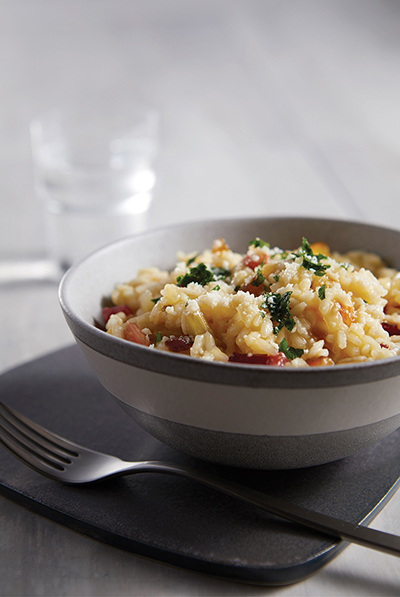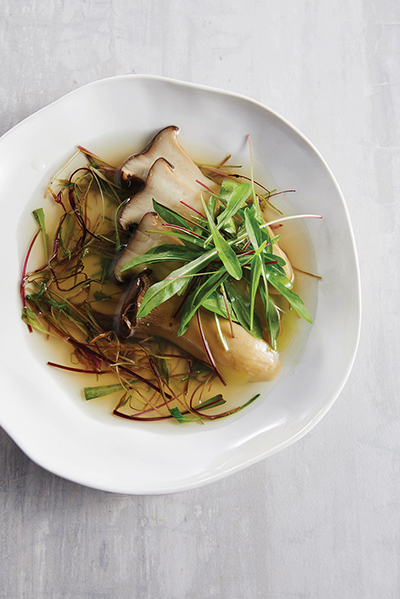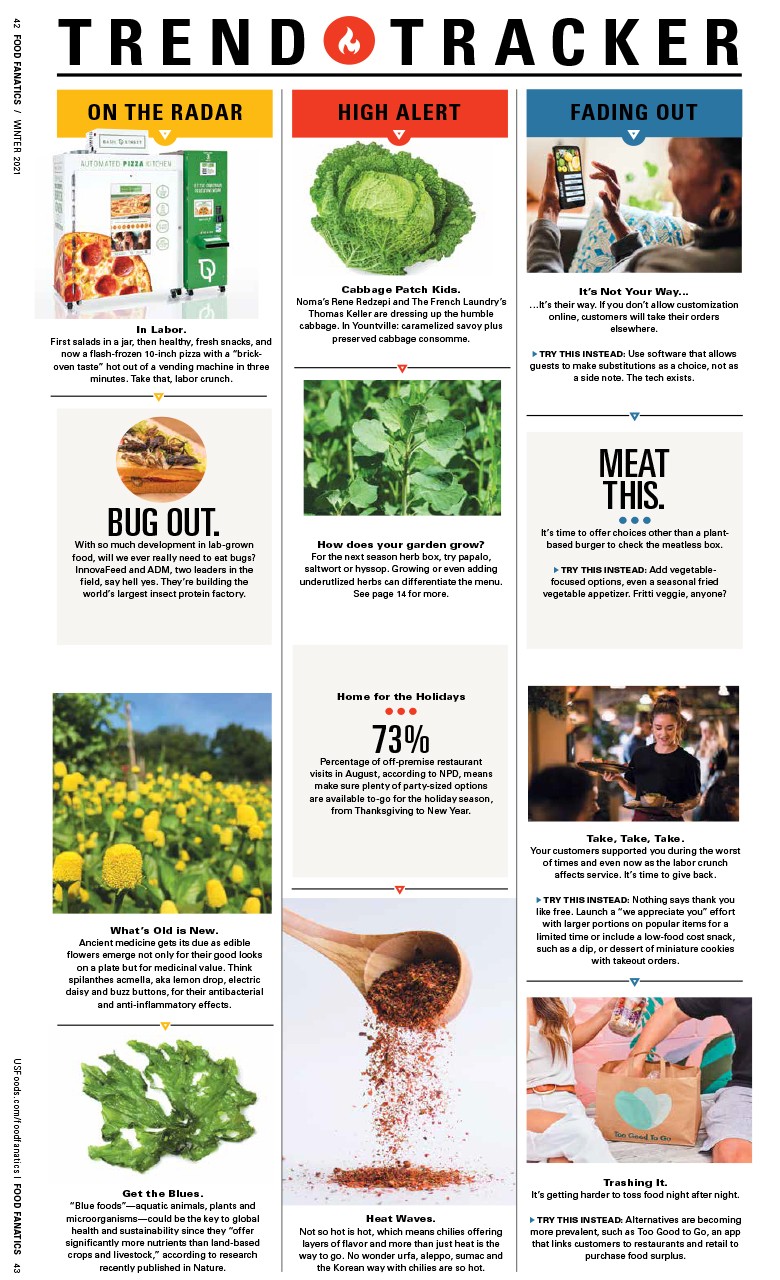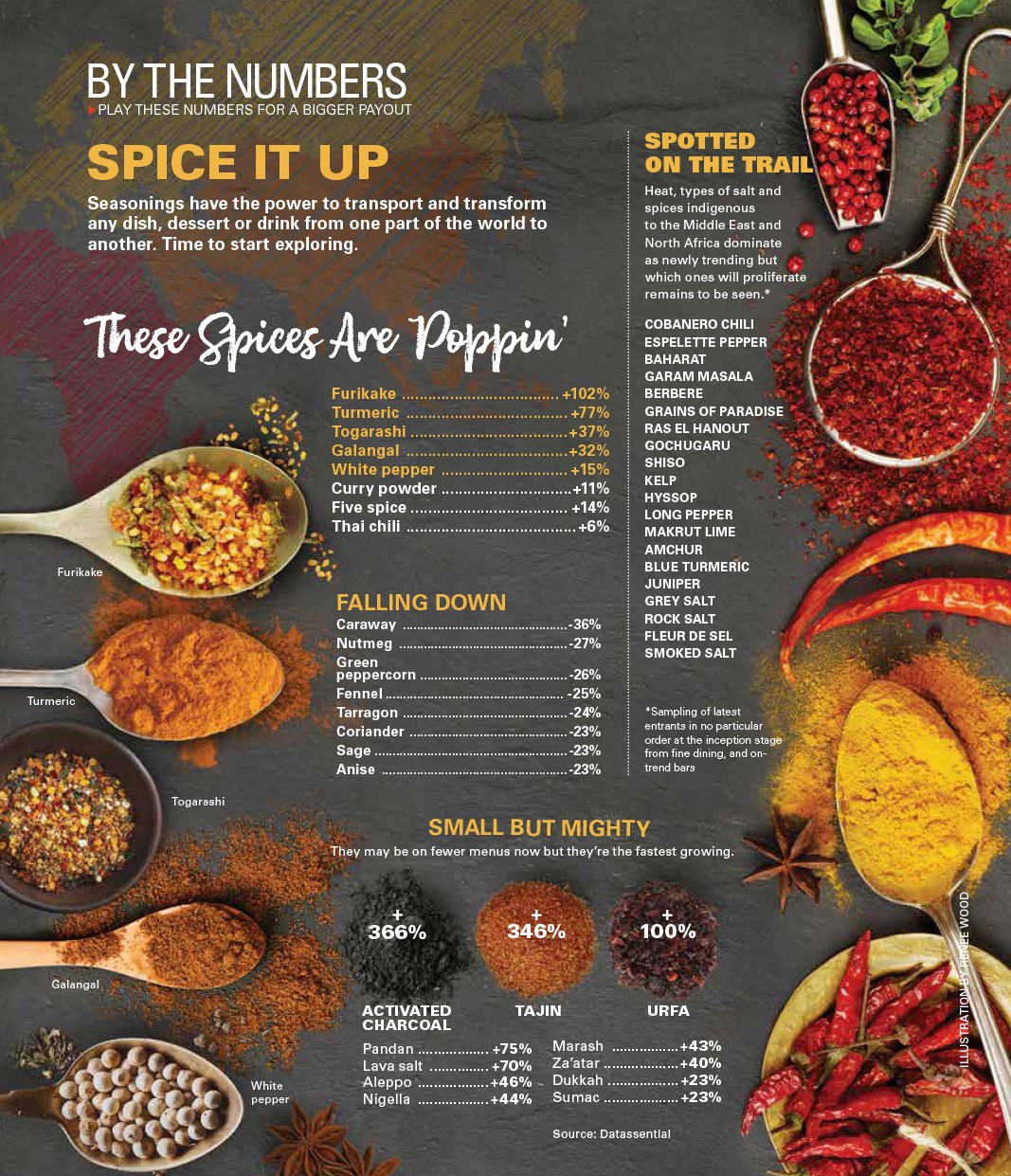TRASH TO TREASURE
Reducing Restaurant Food Waste Increases the Bottom Line
 The waste bins at Kyirisan in Washington, D.C., contain typical food prep detritus – carrot scrapings, citrus rinds, tomato seeds and protein trims. But Chef-Owner Tim Ma doesn’t see trash.
The waste bins at Kyirisan in Washington, D.C., contain typical food prep detritus – carrot scrapings, citrus rinds, tomato seeds and protein trims. But Chef-Owner Tim Ma doesn’t see trash.
He sees money: a precious cache of his razor-thin profit margins being chucked away. Even kitchens that revere ingredients often overlook what could produce meat and vegetable stocks, preserved lemons, simple syrups, meat sauces or tomato water.
“Literally, your dollars are being thrown away,” Ma says. “It is inefficiency, and that makes my blood boil.”
Restaurant food waste is a large and costly issue. According to the U.S. Department of Agriculture (USDA), up to 40 percent of food is wasted, and by many reports, 10 percent of food that restaurants purchase ends up in landfills. ReFED, a waste-focused nonprofit, estimates that restaurants annually toss more than 571,000 tons of food. That said, college campuses are shaping more eco-conscious minds while some restaurateurs are combating mindless and unnecessary restaurant food waste by applying a farm-to-table ethos to scraps and recognizing the dollars-and-cents downside of waste.
“Once it becomes a business issue, you have to deal with it,” says Ma. “At some point you realize it saves money to track waste and see to its reuse. That’s when things start to change.”
Dan Barber, chef-owner of Blue Hill restaurant in New York City, has been one of the strongest proponents of a full-on cultural change. In his world, whey from cheese making is redirected to bread, and the pulverized pulp from the juiced vegetables becomes veggie burgers. While Barber’s model and the $258 per person Blue Hill prix-fixe tab aren’t solutions for all operations, he’s elevated the discussion from the fringes to the mainstream.
FARM TO FORK TO FARM
As owner of two restaurants and a 130-acre farm, Eric Skokan runs a tightly synced system of food-use efficiency. Menus at Black Cat Bistro and Bramble & Hare in Boulder, Colorado, are freshly packed with ingredients grown and raised at nearby Black Cat Farm.
“We produce it; we respect it,” says Skokan. “Butt ends of broccoli, bell pepper seeds and carrot peels are tossed in buckets, taken to the farm and fed to pigs. Meat scraps go to chickens. You could think of that motion, saving and hauling scraps, as one step in a cycle. The chickens and pigs end up at the restaurants.”
 Efficient utilization and re-utilization of food is woven into the restaurants. “I brainwash cooks to follow that model. No. 1 to making it work is creating a culture where the nickels and dimes of scraps matter. Price per pound, chard stems cost the same as leaves. If you toss the stems, the cost of your leaves doubles. Presented to cooks that way, the financials come into focus, and they’ll find a way to make it work,” Skokan says.
Efficient utilization and re-utilization of food is woven into the restaurants. “I brainwash cooks to follow that model. No. 1 to making it work is creating a culture where the nickels and dimes of scraps matter. Price per pound, chard stems cost the same as leaves. If you toss the stems, the cost of your leaves doubles. Presented to cooks that way, the financials come into focus, and they’ll find a way to make it work,” Skokan says.
Building flexibility into menus helps Skokan stay ahead of food waste.
“I took a step back from the menu writing process to find ways to use scrap bits,” he says. “A dish like risotto comes to a new level of importance. It’s a basic dish that can use a host of ingredients. Instead of writing it as risotto with prosciutto and arugula, we say risotto with prosciutto and farm vegetables. That creates space to adjust the make-up of the plate when we need to.”
MOVING TO A ZERO WASTE MENU
At Kyrisian, Ma says that fostering a zero waste culture is often more difficult than dreaming up applications for the scraps themselves. “It’s a constant gentle pressure of ‘Hey, we want to be mindful of food and respect how we prepare it.’ Take carrots: tops go into pesto, peels go into stock and the carrots are carrots.”
A concise and tightly edited menu helps stanch waste. “It’s better to have 12 items done well than 24 that are half-assed,” Ma advises. “A 24-item kitchen is exponentially more complicated. Every ingredient brought in is another potential for waste.”
His kitchen is particularly adept at utilizing trim from costly seafood items. His scallop dashi reclaims abductor muscles from scallops, gently leveraging their sea-sweet taste in a yuzu-spiked broth that’s partnered with oil-poached trumpet mushrooms. Dandelion greens finish the dish. “Tops are tender, stems chewy. We use both. Stems go on the plancha where they become tender. Greens go on top,” says Ma.
PURCHASE INVENTORY WISELY
Mindful inventory decisions can impact the amount of food waste you produce. Point of sale software today includes tools that track inventory and sales patterns to ensure smarter ordering.
Jehangir Mehta, a food waste consultant and chef-owner of New York City’s Graffiti Earth, says he’s not afraid to 86 a dish when the line runs out of ingredients to make it.
“People buy too much, afraid they’ll run out. With our intimate service style, it’s okay for me to have just one order of a dish,” he says, adding that regulars consider it a badge of honor to nab a one-and-done dish.
Although running a small 18-seat restaurant helps ensure his team can catch valuable food scraps before they hit the trash, Mehta’s consulting work for the University of Massachusetts, Amherst – where 50,000 students, faculty and other diners are served daily – proves the same tactics work in large operations as well. “By capturing vegetable peels to make stock, food cost on a soup fell from 28 percent to 12.3 percent,” he says.
The key is to get creative with leftovers: Unused prep ingredients from an omelet station work in fried rice. Cheese and meat ends can go into chef salads. Extra grains can become bread or rice pudding. And pulled chicken sandwiches with soup can be buoyed by the carcasses and drippings culled from rotisseries.
Ken Toong, executive director of auxiliary enterprises at UMass, was quick to embrace Mehta’s discoveries. “A financial model built on waste is unacceptable,” he notes, adding that students are keenly attuned to the school’s efficient use of food resources.
Black Cat’s Skokan is just as tuned in. “There’s almost always a way to turn scraps into something spectacular and sought after. It transforms the bottom line in a powerful way, and cooks are more engaged because they use their brains. It’s not just a win-win. It’s a win-win-win-win.”
WASTE NOT, GET MORE: TIPS FROM THE WASTE-CONSCIOUS
Tim Ma, Kyirisan:
- Pinpoint where your restaurant food waste issues originated. Is it purchasing? Forecasting? Bad prep or planning?
- Challenge chefs to find creative ways to use leftover foods or aging product for family meals.
- Portion control is important: Think reasonable portions and reasonable price control costs.
- Chefs can become fortune tellers – nothing 86ed, no excess, a near-empty walk-in on Sunday nights. Attack it as “Let’s order exactly what we need.” If we run out, we fix it some other way.
- Jehangir Mehta, Graffiti Earth:
- Rethink menus for business meetings. If you’re serving 10 people for breakfast, order five croissants, bagels and muffins instead of 10. Guests won’t fret over eating a bagel instead of a muffin.
- Focus on utilizing food in unorthodox formats. Make citrus water with the peels, pickle melon rinds, make preserves, chutney and spicy marmalade. There’s a use for everything.
- Single-use items can lead to trouble. Try to have at least two uses for all food inventory items.
BUILD FOOD-FLEXIBLE, ZERO WASTE MENUS
Eric Skokan’s frequently changing menus at Black Cat lures in diners and gives the kitchen room to improvise when arugula slumps or the bounty of root vegetables yields surprises.
EXAMPLES:
- Hamachi crudo with fennel and citrus salad, chili oil
Calling out less common citrus fruits, such as blood oranges, may be trend-worthy but doesn’t accommodate other citrus living out its final days in the walk-in. A citrus salad, however, accommodates grapefruit, lemon, lime, pomelo, oranges or kumquats.
- Tunis lamb with cauliflower couscous, mushroom, parsnip, seared greens and pistachio tarator
Specifying seared greens rather than seared spinach offers flexibility, while a tarator allows for various herbs or even greens
- Mulefoot pork with fingerling potatoes, Brussels sprouts, pepper stew and mole
If there’s no time to make green, white or red mole, swap red fingerlings for yellow potatoes and make a stew from sweet bells or sassier poblanos.
- Root vegetable soup with thyme crème fraiche
Carrots, parsnips and rutabaga work as well as celery root, potatoes and boniato.



